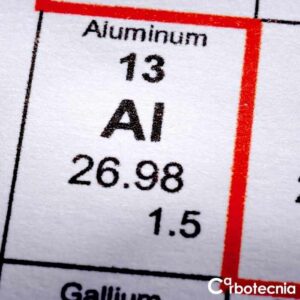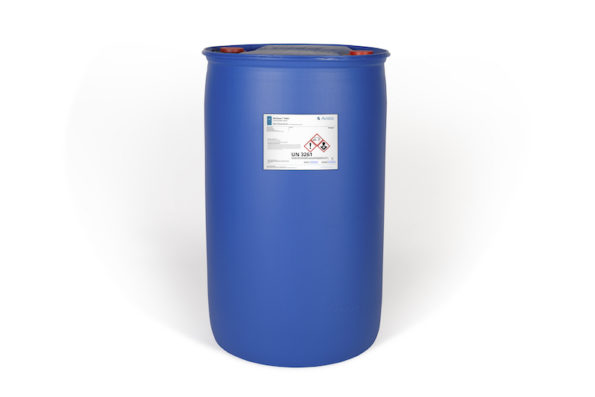
Aluminum in drinking water
Water is the vital resource that sustains life on our planet. However, when aluminum, a common element, infiltrates our drinking water sources, it can pose serious concerns for human health and the environment. Aluminum is a contaminant that can reach drinking water through various industrial and natural processes. In this article, we will explore in detail the issue of aluminum in drinking water and why it is crucial to eliminate it. We will discuss the risks associated with aluminum exposure, ranging from neurological problems to gastrointestinal problems. In addition, we will examine technologies and strategies that can be used to reduce the presence of aluminum in our water sources and ensure that our drinking water is safe.
Joining efforts to eliminate aluminum from drinking water is essential to protect the health of communities and preserve the quality of our most precious resource. Join us in this exploration to understand why removing aluminum from drinking water is a critical mission that deserves our full attention.
What is aluminum?
Aluminum is a silver-colored element, very light and easy to handle, besides being very resistant to corrosion, low toxicity and a good thermal conductor. Its symbol is Al, it has an atomic weight of 26.98 g/mol, is number 13 on the periodic table and is part of group IIIA. It is the most abundant metal on the planet, naturally occurring in combination with oxides and silicates.
Aluminum is alloyed with small amounts of copper, magnesium, silicon, manganese and other elements to improve its strength and usefulness, mainly in the production of construction materials. This element is widely used in the manufacture of products, as well as in the structure of equipment that performs operations in any industrial process. Some examples of use are: doors, windows, food containers, kitchen utensils, locks, among others (1); and equipment such as tanks, distillation towers, ovens, mills, boilers, etc.
This element has the curious characteristic of always remaining oxidized, because it is highly reactive with oxygen. On its surface a micro layer is formed, made up of aluminum oxide (alumina, Al2O3), is silver-colored (therefore oxidation is not noticeable as with iron or copper), and gives it properties that make it resistant to corrosion and different chemicals (except strong acids and bases). Usually, an anodizing process is implemented to make it even more resistant, which is why aluminum is widely used in manufacturing materials for equipment, tools, electronic devices, etc.
 Does aluminum cause harmful health effects?
Does aluminum cause harmful health effects?
This element is considered non-toxic, since Mexican standards consider a permissible aluminum limit of up to 0.20 mg/l in drinking water (2). There is not enough information about whether aluminum significantly affects human health, because although the human body is always exposed to this element due to its abundance in the environment, there is no relationship with harmful health effects.
It can be found in very low amounts in the water we drink and in foods, but there is no scope for the metal to affect our organism. When it is considered a health risk, it is when there is a high exposure to it.
Large amounts of aluminum administered orally can cause irritation of the gastrointestinal tract and lead to other health problems as a result of high ingestion of drugs containing aluminum as part of the formulation.
Another case is that of people who may be exposed to aluminum dust (for example, in industrial processes), and may have severe problems in the respiratory system. The health problems caused by aluminum are then due to excessive contact, either by ingestion (mainly medicines containing it) or by high exposure to it.
There have been studies about a possible relationship between aluminum and Alzheimer’s disease, however, there are other studies that contradict this, reporting that there is not enough evidence to confirm this relationship.
 Does aluminum cause Alzheimer’s?
Does aluminum cause Alzheimer’s?
Aluminum has been found to cause at least one severe form of dementia, but only in a very specific group of people: dialysis encephalopathy. It affects some patients with impaired kidney function who need to clean their blood and who use dialysis to absorb large amounts of aluminum salts. These salts have long been used to eliminate excess phosphate from the body. Some metal got into the blood. As a result, the patient developed progressive brain damage leading to severe memory loss. The reason is not clear.
The most likely hypothesis is that aluminum alters the calcium balance in nerve cells. However, this was not confirmed in the end. The osmotic fluid is usually free of aluminum salts. As a result, aluminum has been shown to be harmful to the brain, but most researchers believe that this only occurs under extreme conditions and not in the amounts we normally ingest through food or water. The idea of a possible link between Alzheimer’s disease and aluminum is based on the known neurotoxic effects of the metal and the fact that some researchers have found elevated levels of aluminum in the brain. Tau protein aggregates in patients with Alzheimer’s disease are a typical feature of this disease.
 How does aluminum enter the body?
How does aluminum enter the body?
The largest source of aluminum that people come into contact with is food. Aluminum is one of the most abundant elements in the earth’s crust, so it is present in certain quantities in most food products, especially dried herbs and spices, with an average of 145 micrograms/gram, and chocolate products contain 33 micrograms. Each gram depending on the dosage form, up to 1% of the food is absorbed in the gastrointestinal tract, so only a small part of the aluminum in food enters the body directly. In addition, this metal is present in drinking water and is consumed in large quantities together with drugs, especially antacids (containing basic aluminum hydroxide, which, depending on the dose, a person ingests between one and two grams of aluminum salts.
Another source of aluminum isantiperspirants to prevent underarm sweating, but deodorants and antiperspirants have been found to have minimal dermal absorption of the metal in studies. In this case aluminum compounds such as aluminum chloride or various aluminum hydrochlorides dissolved in water. Their action is somewhat mechanical: they precipitate proteins, thus obstructing the sweat glands (experiments have shown that it is sufficient to remove the top layer of the epidermis with adhesive tape to unblock and allow the return of perspiration). due to the formation of sweat, it can no longer escape, but the gland absorbs the stagnant liquid.
Animal studies have shown that chronic intoxication would require the ingestion over long periods of time of 50 or 100 milligrams of aluminum per kilogram of body weight per day. And to put some context, an EFSA (European Food Safety Authority) study, workers in an aluminum industry take about 40 milligrams of the metal per working day.
 Where in the body does it accumulate?
Where in the body does it accumulate?
There is no clear answer to this question. In the body, it is distributed in different tissues, although unevenly. Approximately half remains in the bones and a quarter in the lungs, but it is also transported through the cerebrospinal fluid to the brain. Aluminum levels in all tissues increase with age. Animal experiments have shown that when calcium and iron are deficient, more aluminum accumulates in the brain and bones. This distinctive tissue distribution has a direct impact on the amount of time aluminum remains in the body.
 How is aluminum eliminated from the body?
How is aluminum eliminated from the body?
The retention of metals in the human body varies due to multiple factors. This has led scientists to conduct aluminum removal studies, where they resort to isotope-labeled aluminum compounds. About 60% is excreted by the kidneys within a day, but long-term observations indicate a half-life of up to 50 years. According to one study, the metal disappeared from the rats’ brains after four and a half years.
Is aluminum present in the air?
The content of this metal in the air is very low, from 0.5 ng/m3 in Antarctica, to 0.005 mg/m3 in rural areas, to 0.01 mg/m3 in industrial areas, concentrations can exceed 13.
On the other hand, airborne aluminum binds to large suspended particles that do not easily enter the bronchial tree. For both of the above reasons, inhalation exposure is not the most important route of exposure in the general population, although it may occur in some occupations with high exposure.
Presence in pharmaceutical and cosmetic products
It can be assumed that the consumption of pharmaceuticals, antacids and analgesics containing aluminum increases metal binding by 2 to 3 orders of magnitude relative to food intake. The FAO (Food and Agriculture Organization of the United Nations) recommends a weekly dose of 420 mg9 for a 60 kg adult. On the other hand, dialysis patients may be exposed to moderately elevated concentrations of metals. This international organization recommends that the maximum aluminum content of dialysis fluid should be less than 15 µg Al/10.
Hemodialysis encephalopathy has been described to present with metal-induced neurotoxicity. However, the neurodegenerative changes observed in these cases differed at the molecular level from those associated with Alzheimer’s disease. Finally, aluminum compounds are used in the cosmetics industry, mainly in the production of deodorants and antiperspirants, although studies have shown minimal metal absorption through the skin.
Occupational and industrial exposure
Workers in the aluminum industry (producing, manufacturing and welding) may be exposed to high concentrations of aluminum. It has been suggested that this group of workers has slightly elevated serum and urinary aluminum concentrations, and that there may be a systemic physiological response to absorption and elimination.
In what form is aluminum present in water?
First, it is necessary to understand how aluminum behaves in water. In water treatment plants, it is common to use aluminum sulfate salts as a coagulant for better filtration. These salts are inexpensive and widely used. Aluminum is not only used in water treatment plants, but also in a wide range of applications, such as the steel, food, pharmaceutical, cosmetics, etc. industries.
Drinking water during the filtration and treatment process can be treated with aluminum sulfate as a coagulant, which helps to remove the color and turbidity of suspended particles in the water. At the end of the process, the residual metal content in the water is very low, from 0.014 to 2.7 mg/l. The water that cleans this process is mainly surface water because it contains more suspended particles.
Among other things, the bioavailability of metals in drinking water depends on the pH and the chemical relationships and balance between various solutes such as silicates, citrates, calcium and fluoride. Aluminum chemistry is highly reactive when the pH is between 6 and 8. The World Health Organization estimates that aluminum in drinking water can increase intake by 4.0 mg per day.
 What are the methods for removing aluminum from water?
What are the methods for removing aluminum from water?
Ion exchange and demineralization are some potential methods to remove it from water. In treatment plants (as mentioned above), aluminum sulfate is normally added to the water during the coagulation process, which means that there are higher concentrations of the element in the treated water than in the raw water. When levels are above 0.1 mg/L in distribution systems, discoloration may result. This discoloration is also an indication of liquid treatment problems (lack of pH control, poor coagulation and filtration breaks) (4).
Although aluminum is easily removed from water by cation exchange resins, such as those used to soften water in a water softener, aluminum cannot be easily removed from a resin by salt regeneration. Periodic acid treatment is required to exchange the accumulated aluminum in the resin, so self-healing cation exchange systems are not practical for residential use but for more industrial use.
Reverse osmosis is also a method for the removal of aluminum from water, this when values are below 0.05 mg / l. This method has become much more competitive because of the cost of operation.
In point-of-use (POU) methods, such as reverse osmosis with (>98 % reduction) or distillation (>99 % reduction). When alum (Al2 (SO4) 3 – 14.3H2O) is used in the coagulation process in municipal water treatment, under certain pH conditions, it may precipitate due to the concentration effect in distillation or reverse osmosis wastewater treatment systems.
Aluminum, depending on device design and pH, can damage reverse osmosis membranes. The treatments listed here are generally recognized as technologies capable of effectively reducing the listed contaminants sufficiently to meet the WWA Drinking Water Standards (SMCL). However, this list does not reflect the fact that point-of-use/point-of-entry (POU/POE) devices and systems may vary in their effectiveness in treating specific contaminants and performance from application to application.
Therefore, the selection of a particular device or system to reduce the specified contaminants, in this case Aluminum, should only be made after a thorough investigation of its working capability based on the validation test results, and competent equipment is tested for the specified contaminants. As part of the treatment system installation at the point of entry, the operating characteristics of the system should be verified in accordance with established water testing and analysis procedures.
The resulting water should then be monitored periodically to verify ongoing performance. The use of water treatment equipment should be carefully monitored to ensure that feed water conditions and acceptable equipment capacity are not exceeded.
 References
References
- Editorial Team. What is the chemical element Al used for? I Chemicals. [En línea] 2018. [Cited on: January 16, 2020.] https://iquimicas.com/aluminio-sirve-elemento-quimico-al/.
- MODIFICATION TO MEXICAN OFFICIAL STANDARD NOM-127-SSA1-1994, ENVIRONMENTAL HEALTH. WATER FOR HUMAN USE AND CONSUMPTION. PERMISSIBLE QUALITY LIMITS AND TREATMENTS TO WHICH WATER MUST BE SUBJECTED FOR ITS POTABILIZATION. Diario Oficial de la Federación, Comité Consultivo Nacional de Normalización de Regulación y Fomento Sanitario. 2000.
- REVIEW OF STUDIES ON ALUMINUM EXPOSURE AND ALZHEIMER’S DISEASE. Suay, Loreto and Ballester, Ferran. 6, Valencia: Revista Española de Salud Pública, 2002, Vol. 76. 1135-5727.
- DeZuane, John. Handbook of Drinking Water Quality. Canada: John Wiley & Sons, Inc., 1997. 0-471-28789-X.
Last updated 02/14/2020.
Share:
If you need more information, please contact us.
Some products that may interest you
-
RoClean L211 cleaning of membranes with organic matter fouling
Add to quote -
RoQuest 3000 Organic Liquid Coagulant from Avista
Add to quote -
Titan Antifouling for Reverse Osmosis Membranes
Select options -
RoClean P112 Membrane Cleaner for Silica SiO2
Add to quote -
RoClean P303 Calcium Carbonate & Metal Scale Cleaner
Add to quote -
RoClean P111 Biofouling RO Membrane Cleaner
Add to quote -
RoClean L403 Calcium Carbonate and Metal Scale Cleaner by Avista
Add to quote -
RoQuest 4000 Liquid Coagulant for Organic Matter Avista
Add to quote






























